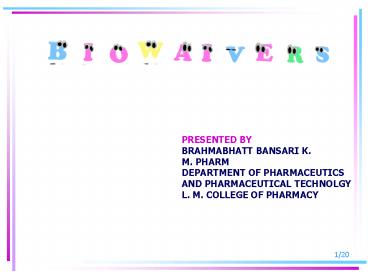Laboratory Notebook - PowerPoint PPT Presentation
1 / 20
Title:
Laboratory Notebook
Description:
presented by brahmabhatt bansari k. m. pharm department of pharmaceutics and pharmaceutical technolgy l. m. college of pharmacy */20 */20 drug products for which ba ... – PowerPoint PPT presentation
Number of Views:1220
Avg rating:3.0/5.0
Title: Laboratory Notebook
1
PRESENTED BY BRAHMABHATT BANSARI K. M.
PHARM DEPARTMENT OF PHARMACEUTICS AND
PHARMACEUTICAL TECHNOLGY L. M. COLLEGE OF PHARMACY
2
Contents of Presentation
Drug products for which BA/BE can be waived
Biowaivers for solid oral dosage form based
on BCS Biowaiver extensions Data to support
biowaivers
3
Drug Products for which bioavailability or
bioequivalence can be waived
Bioavailability is self evident IVIVC BCS based
biowaivers
4
Biowaivers for immediate release solid oral
dosage form based on BCS (FDA Guidance for
Industry)
- Recommendations provided by guidance
5
BCS pillars
Solubility
Permeability
Dissolution
6
BCS drug substance are classified as below
- Class 1 High Solubility, High Permeability
- Class 2 Low Solubility, High Permeability
- Class 3 High Solubility, Low Permeability
- Class 4 Low Solubility, Low Permeability
7
Biopharmaceutics Classification System
- Solubility
- Easy to determine
- Permeability
- Harder to determine
8
Solubility
- Objective to determine equilibrium solubility of
a - drug substance under physiological pH conditions.
- pH-solubility profile of test drug at 37oC in
aqueous media with a pH range of 1 to 7.5 - Shake-flask or titration method
- Analysis by validated stability-indicating assay
9
Permeability
- Extent of absorption in humans determined by
- Pharmacokinetic studies in humans
- Mass-balance studies
- Absolute bioavailability studies
- Intestinal permeability methods
- In vivo intestinal perfusions studies in humans
- In vivo or in situ intestinal perfusion studies
in animals - In vitro permeation experiments with excised
human or animal intestinal tissue - In vitro permeation experiments across epithelial
cell monolayers - Instability in the Gastrointestinal Tract
- Accounts for extent of degradation of a drug in
the GI fluid prior to intestinal membrane
permeability.
10
Permeability Standards
IS Internal standard for Permeability studies ES
Efflux pump substrates
11
DISSOLUTION DETERMINATION
- USP apparatus I (basket) at 100 rpm or USP
apparatus II (paddle) at 50 rpm. - Dissolution media (900 ml)
- 0.1 N HCl or simulated gastric fluid USP,
- A pH 4.5 buffer,
- A pH 6.8 buffer or simulated intestinal fluid
USP. - Compare dissolution profiles of test and
reference products - Using a similarity factor f2.
12
BCS BIOWAIVER (no in vivo BA/BE needed)
- Rapid dissolution relative to gastric emptying
- Class 1 High solubility, High permeability
- Wide therapeutic window
- Excipients used in dosage form should be used
previously in FDA approved Immediate Release (IR)
solid dosage forms - Prodrugs buccal absorption
13
No biowaiver for
- locally applied, systemically acting products
- non-oral immediate release forms with systemic
action - modified release products
- transdermal products
14
Biowaiver Extensions ?!
- Provided that ......
- drug solubility is high,
- permeability is limited,
- excipients do not affect kinetics,
- excipients do not interact ,.....
15
Biowaiver Extensions ?!
- ....then very rapid dissolution (e.g.gt85 in 15
min) of test and reference may ensure similar
product characteristics - because...
- ....absorption process is probably independent
from - dissolution and not product related
- limited absorption kinetics due to poor drug
- permeability and/or gastric emptying
- Biowaiver for BCS class III drugs (e.g.
Atenolol)?!
16
Biowaiver Extensions ?!
- For drugs showing ....
- very high permeability
- pH-dependent solubility within the
physiologically relevant pH range - .....an intermediate solubility class is
suggested
17
Data to support Biowaivers
- Data supporting
- High solubility
- High permeability
- Rapid and similar dissolution
18
- Write note on drug products for which BA/BE
- studies can be waived. (5 marks)
- Write note on BCS based biowaivers. (5 marks)
- Enlist the methods to determine the permeability
- of drug substance. (2 marks)
- Comment on Biowaiver extensions. (2 marks)
19
REFERENCES
- http//ikev.org/haber/bioav/Barends_Istanbul2004-
1_korr.pdf - http//www.absorption.com/site/Services/BCS.aspx
- http//ikev.org/haber/bioav/BA-BE20Intro-01-30-co
lor.pdf - http//medicine.iupui.edu/clinical/F813_spring2006
/S_ClinicalPKF813Lecture1709March2006Bioavailabili
tyandBioequivalencerevised.pdf - http//www.sfbci.com/SFBC/upload/sfbc/Generateur/L
eonShargel.pdf
20
(No Transcript)




























![READ [PDF] Enjoy The Little Things Microbiologist Notebook Gift: Labor PowerPoint PPT Presentation](https://s3.amazonaws.com/images.powershow.com/10082113.th0.jpg?_=20240719104)


![[PDF] DOWNLOAD Lab Notebook: For Biology Laboratory Research or Colleg PowerPoint PPT Presentation](https://s3.amazonaws.com/images.powershow.com/10086178.th0.jpg?_=20240726086)